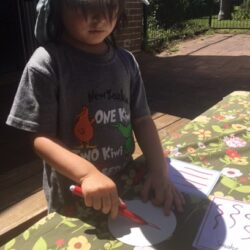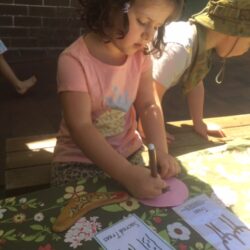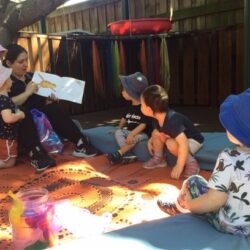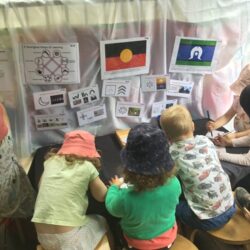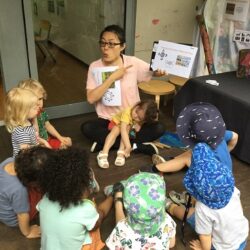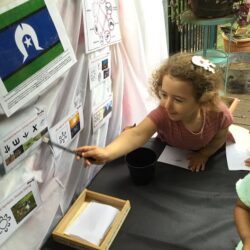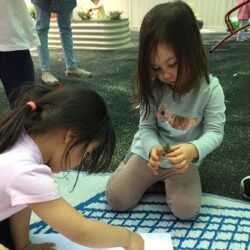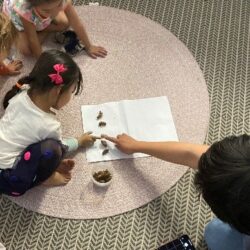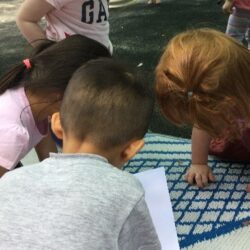Johnson House
Story by Educator Alisa
While the children in Johnson House have recently been exploring Indigenous books, paintings and artworks that have a variety of patterns and symbols, they have been curious about what these patterns and symbols mean or represent. At the drawing table the children were offered some of the common Aboriginal symbols found in paintings and books to explore. The children examined the symbols and they named the ones they could identify, such as trees, the sun and moon, rain and mountains. They were also invited to draw the symbols and to consider how Indigenous people made meaning through these. As the children studied the Aboriginal symbols, they also learnt about other ways of writing and making meaning through stories and paintings. They understand that symbols are a way of making meaning. The children were also able to experiment with a variety of ways of representing their ideas, using both verbal and non-verbal language, and combining different lines types, such as straight, zigzags and swirls in drawing.
Murray House
Toddlers
Story by Educator Mandy
Over the past few weeks the children in Murray House toddlers have been learning about Aboriginal symbols as they read the book Bittangabee Tribe: An Aboriginal Story from Coastal New South Wales by Beryl Cruse. Educator Mandy has incorporated the symbols in Aboriginal art ‘people sitting’ and ‘meeting place’ into our check in/gathering group time that starts our day.
In our endeavours to incorporate the eight Aboriginal ways of learning through symbols and images, the children are being encouraged to learn about other symbols, such as those for ‘boomerang’, ‘mountain’, ‘campfire’, ‘snake’, and ‘kangaroo’ and so on. These learnings are contributing to the children’s early literacy development and learning to write, as they create their own interpretations of a “curly-wurly snake” slithering around, a kangaroo jumping “boink boink!”, or possum and kangaroo foot print, etc.
Infants
Story by Educator Jung
To help our young children in Murray House infants to understand the daily routine and to inform them about the planned experiences that are available for them to engage in throughout the day, our educators have started to have structured group times for the children at the beginning of the day.
Our educators use visual cards to guide the children through the sequence and activities of each group time. Each group time consists of a ‘welcome song’ at the beginning to greet each child and to help them to feel a sense of belonging, followed by singing the Wangal Land song to acknowledge and show respect for Australia’s first peoples. Reading books and singing nursery rhymes related to the children’s current interest then follows. The stories Brown Bear Brown Bear, What Do You See, by Bill Martin, Jr. and Eric Carle, and Aussie Animals, written by Rod Campbell, are two of our children’s current favourites. We close each group time with a ‘goodbye song’ and talk with children about some of the planned experiences that are expected to happen through the day.
Our educators are amazed to see the children developing learning dispositions such as enthusiasm and persistence as they participate. One of our families commented about the group time, saying that their child loves talking about the books that we read during the group and that they enjoy singing the Wangal Land song at bedtime! Educators are feeling grateful to hear the valuable feedback from families and they enjoy seeing our young children demonstrating that they are capable in all learning areas.
Rigby House
Counting Cicada Shells
Story by Centre Director Isa
The outdoors is a powerful motivator for children’s learning. At The Infants’ Home we have beautiful grounds which our children enjoy exploring. The children at Rigby House are interested in cicadas again, and every day they ask to go on “Cicada hunts” to see if we can find cicada shells or even spot a live cicada. The children are keen to find out how many cicada shells they have collected after each outing.
Through these counting experiences, educators are supporting the children to continue to develop their numeracy skills and their understanding of ‘quantity’. The children are learning that, as they count, the number they say should match an individual cicada shell (one-to-one correspondence). They understand that the last number they have said tells them how many cicada shells they have.
Lately we have started to explore addition and subtraction, and the children are fascinated that they can make the quantity bigger or smaller simply by adding or taking away a cicada shell.
